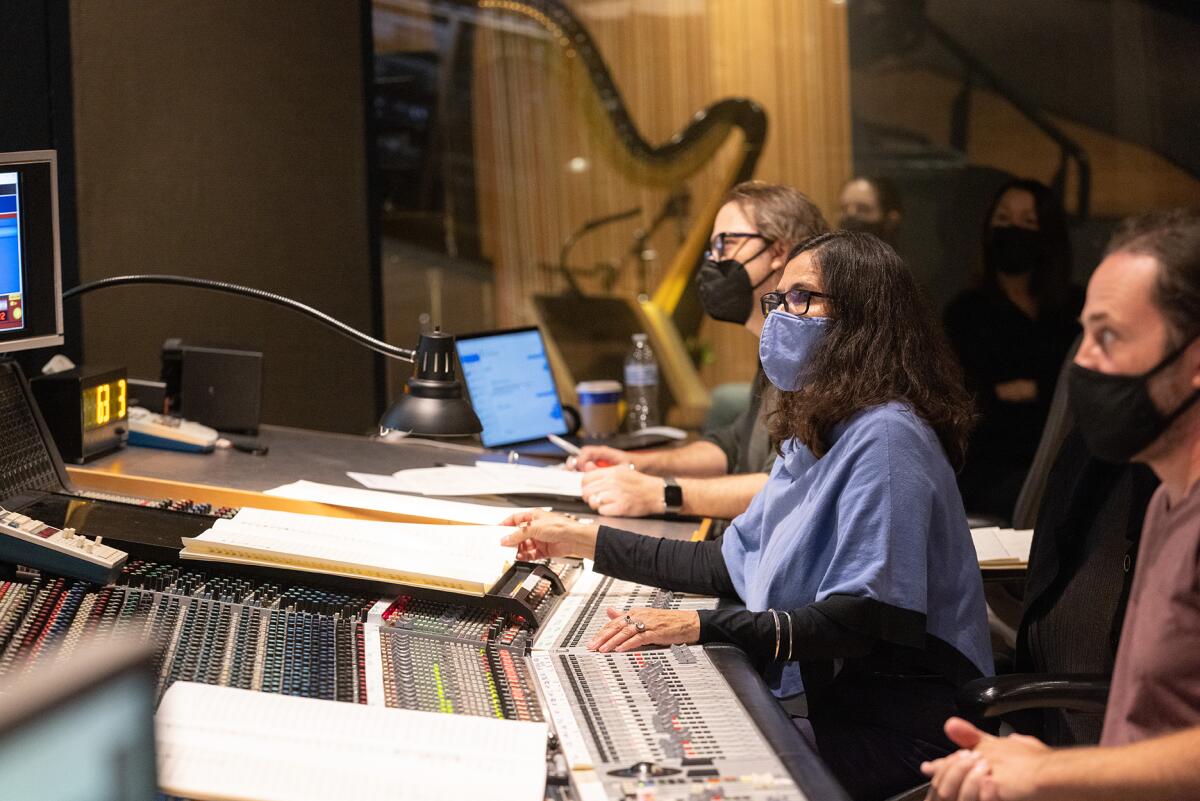We should talk about history-making, Oscar-nominated ‘Encanto’ composer Germaine Franco

Disney’s “Encanto” — a story about the Madrigals, a magical family fighting to save their equally enchanted home in the hills of Colombia — has bewitched viewers young and old. And while the animated film’s “Dos Oruguitas” is nominated for original song at Sunday’s Academy Awards, and the broadcast will feature the first-ever live performance of the soundtrack’s surprise No. 1 hit “We Don’t Talk About Bruno,” there’s someone else we should be talking about this Oscars season: Germaine Franco, the award-winning Mexican American percussionist and composer of the spellbinding score behind “Encanto.”
Upon the movie’s November release, Franco became the first woman ever to score a Disney animated feature film. Shortly after, she became the first Latina to join the music branch of the Academy of Motion Picture Arts and Sciences; then by February, she was nominated for original score, the first Latina and woman of color to be nominated in the category.
“Latinos gotta represent when we can!” says Franco, beaming from inside her studio in Los Angeles. Before “Encanto,” she wrote songs for the beloved 2017 film “Coco” — “Who wouldn’t do a story about a Mexican musician trying to make it?” she asks — and assisted English composer John Powell in scoring features such as “Happy Feet,” “Bolt” and “Kung Fu Panda,” with Hans Zimmer.
Lin-Manuel Miranda plumbed the depth of his experiences — familiar, new and imagined — to craft ‘Dos Oruguitas,’ his Oscar-nominated song from ‘Encanto.’
Franco is already a decorated composer: She received the prestigious Shirley Walker Award at the 2018 ASCAP Awards, which honors those “whose achievements have contributed to the diversity of film and television music.” This particular honor comes to mind as we discuss this year’s Oscars, where she will be the lone woman contending with a murderers’ row of past Oscar nominees, including “Dune” composer Zimmer, who previously won for original score for 1994’s “The Lion King,” and Radiohead guitarist and composer Jonny Greenwood, who’s currently in the running for “The Power of the Dog.”
“I believe in the music, and I believe in myself,” says Franco. “But many people have helped me along the way. Many people wanted this film to happen.”
As intimidating as the competition may be, the enduring charm of the music behind “Encanto” could work in Franco’s favor. The soundtrack, featuring eight songs written by Lin-Manuel Miranda, charted at the top of the Billboard 200 for nine weeks.
“When Lin-Manuel calls you up, you go for it,” says Franco, who was recruited by Miranda following her work on “Coco.”
“Lin creates beautiful worlds in his songs, and since I came later, I wanted to do my best to stay in the world that he started with,” she adds. “There was a synthesis, an interconnectedness that opened up our creative vision.”

Franco was born in Oxnard and raised in El Paso, Texas. Her family, who migrated north from Chihuahua and Durango after the Mexican Revolution, settled in El Paso and Ciudad Juárez, which sit on opposite sides of the U.S.-Mexico border. Franco fondly remembers passing mariachis and other street musicians in the plazas as she and her family crossed the border to hang out with family after church on Sundays. “Back then, it was just like going to Van Nuys,” she says with a chuckle.
The regional Mexican ballads her grandfather loved, in tandem with the contemporary American sounds of Steely Dan, Stevie Wonder and Herb Alpert, shaped the basis of Franco’s lifelong passion for music. By the fifth grade, she turned her enthusiasm for banging on pots and pans into a dedicated course of study, taking lessons in piano and percussion — the latter of which she performed with the El Paso Symphony Youth Orchestra.
“People tried to make me play violin or flute because that’s what girls play,” recounts Franco. “And I said, ‘No! I’m playing the drums!’”

After graduating at the age of 16, Franco followed her brother, the multimedia artist Michael Petry, to Rice University in Houston. While earning both a B.A. and M.A. from the Shepherd School of Music, she worked in the pit orchestra at the local theater and played lively college parties with a Latin jazz band.
“People went nuts,” she says, flashing a black-and-white photo from her teenage years in which she’s rocking out blithely with a marimba band in Mexico. “I noticed that they responded more to the Latin stuff than the straight jazz.”
Upon finishing her studies, Franco became a professional orchestra player in Europe: first in the Spoleto Festival Orchestra in Italy, then in Berlin’s world orchestra. Still, she found herself yearning to delve into the sounds of Latin America.
“I was living a double life,” she says. “During the day, I played classical music with a group that spoke 40 different languages. Then at night, I jammed with the salsa bands … I wanted to play music that felt more free.”
“Germaine is Mexican, but she’s like a musical sponge — she absorbs every little thing she hears, sees and touches as information,” says Cuban percussionist Luis Conte. He had just recorded with Madonna on her album “Like a Prayer” when Franco first saw him at a conference in Los Angeles. She cold-called him, seeking an apprenticeship. Conte took Franco under his wing while recording his 1989 album, “Black Forest” — and more than 30 years later, she returned the favor by enlisting him to join the percussion ensemble that gave “Encanto” its tropical verve.
“She is rare,” Conte tells The Times. “A lot of composers don’t usually come out and play with the bands, but Germaine came out, picked up a xylophone and jammed with us.”
After scoring a few independent films and working as a music director for the Los Angeles Theatre Center, Franco adopted another crucial mentor, this time in the movie industry: an old colleague of her brother’s named John Powell. As his assistant, she helped him score and orchestrate 35 feature films over the course of 11 years, starting with 2003’s “The Italian Job” — but along the way, she discovered a special affinity for the dynamism of animated features. “I have a son, and I wanted him to be able to see some of the stuff I worked on,” she says.

Franco’s skill set, not to mention her unique perspective as a Latina composer, was growing in demand. She left her post with Powell and headed to Mexico, where she helped orchestrate what became the dazzling soundtrack to “Coco” — and, amid external pressures on Hollywood to diversify, she began thinking more critically about the role she was called to play in the industry.
“I wanted musicians who did banda, I wanted música romántica, but I also wanted more women,” recalls Franco. “We had two singers and one woman that played an accordion. One musician, who will remain unnamed, did not like the fact that I was a Latina telling him what to do. It turned out beautiful. But I was like, ‘Come on. Is it that bad?’”
Five years later, it was that same intrepid spirit that colored the making of “Encanto.” Even though Franco was familiar with the Colombian folk sounds of cumbia, vallenato and joropo, she had never been to the country herself and couldn’t travel there safely because of the pandemic.
“It’s not a documentary, so I didn’t need to be a purist,” she says. “But to tell a Colombian story, I had to bring a bit of Colombia into my space. So I had instruments sent to my house — cuatros, tamboras, the arpa llanera [a harp]. I also had a marimba de chonta made with a special wood from a palm tree.”
Franco held video conferences with members of the backing band for Colombian singer Carlos Vives, which included vocalist Isa Mosquera and flutist Mayté Montero, who specializes in playing a woodwind instrument known as the Colombian gaita. She also consulted Colombian sax and clarinet player Justo Almario, as well as a quartet of cantadoras, a group of female Afro-Colombian folk singers from the region of Palenque, to record via Zoom. (You can hear their voices soaring over the earth-quaking rumble of strings and percussion in a theme for the Madrigal family’s youngest boy, “Antonio’s Voice.”)
“‘Encanto’ has a female protagonist,” says Franco. “The story itself is so feminine. We needed [more] female voices. And to have support for that, to get the resources to do that from Disney, it really does lift everybody up.”
More to Read
The biggest entertainment stories
Get our big stories about Hollywood, film, television, music, arts, culture and more right in your inbox as soon as they publish.
You may occasionally receive promotional content from the Los Angeles Times.












